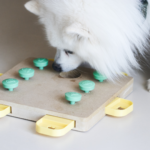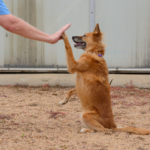Are you frustrated by your dog’s misbehavior and looking for effective techniques to train them? Look no further! In this article, you will discover proven methods for dog behavior training that will help you transform your furry friend into a well-behaved companion. From basic commands to addressing common behavior issues, this comprehensive guide aims to provide you with the tools and knowledge you need to build a strong bond with your four-legged friend. Get ready to embark on a rewarding journey towards a harmonious relationship with your canine companion.

Understanding Dog Behavior
The Importance of Understanding Dog Behavior
Understanding your dog’s behavior is crucial for building a strong bond with your furry friend. Dogs have their own unique ways of communicating and expressing themselves, and being able to understand their signals will lead to better communication and a more harmonious relationship. By understanding their behavior, you can also identify any potential issues or problem behaviors early on, allowing you to address them effectively.
Canine Communication Signals
Dogs communicate through a variety of signals, both verbal and non-verbal. Learning to recognize these signals can help you better understand what your dog is trying to communicate. Verbal signals include barking, whining, and growling, while non-verbal signals involve body language, such as wagging tails, erect ears, raised hackles, or crouched posture. By paying attention to these signals, you can gauge your dog’s emotions and needs, and respond accordingly.
Dog Body Language
A dog’s body language is a crucial aspect of their communication. Knowing how to interpret their body language will enable you to understand their emotional state, whether they are feeling happy, fearful, anxious, or relaxed. For example, a wagging tail usually indicates happiness or excitement, while a tucked tail may signal fear or submission. Other body language cues to look out for include eye contact, posture, ear position, and facial expressions. By observing your dog’s body language, you can gain valuable insights into their emotional well-being.
Positive Reinforcement Training Methods
Reward-Based Training
Positive reinforcement is a highly effective and humane training method that focuses on rewarding desired behaviors rather than punishing unwanted ones. By rewarding your dog for doing something right, such as obeying a command or exhibiting good behavior, you are reinforcing positive associations and encouraging them to repeat that behavior. This positive approach fosters a strong bond between you and your dog while promoting their confidence and willingness to learn.
Using Treats and Toys as Rewards
Treats and toys are excellent motivators and can be used as rewards during training sessions. When your dog successfully performs a desired behavior, you can provide them with a tasty treat or engage in a game with their favorite toy. This reinforces the idea that good behavior results in something positive and enjoyable. Remember to use small, bite-sized treats to prevent overfeeding during training sessions and consider using a variety of treats to keep your dog engaged and motivated.
Marker Training
Marker training involves using a distinct sound, such as a clicker or a specific word, to mark the exact moment your dog performs a desired behavior. This method helps create a clear and instant association between the action and the reward. For example, when teaching a dog to sit, you would click or say “yes” the moment their rear touches the ground, followed by rewarding them with a treat. The marker serves as a communication tool, signaling to your dog that they have done something correctly and will receive a reward.
Consistency and Repetition
Setting Clear Expectations
Consistency is key when it comes to dog training. By setting clear expectations and consistently enforcing rules, you help your dog understand what is expected of them. This includes establishing boundaries within your home, teaching them basic commands, and reinforcing good behavior. Clear expectations provide structure and guidance for your dog, making it easier for them to understand and meet your expectations.
Repeating Commands
Repetition is an important part of training as it helps reinforce the association between a command and the desired action. When teaching your dog a new command, such as “sit” or “stay,” it is essential to repeat the command consistently and reinforce the behavior every time they respond correctly. Over time, your dog will begin to recognize the command and understand what is expected of them.
Consistent Reinforcement
Consistent reinforcement is necessary to reinforce desired behaviors and deter unwanted ones. Whenever your dog exhibits good behavior, it is crucial to provide immediate positive reinforcement, such as praise or rewards. This reinforces the idea that they are on the right track and encourages them to continue behaving appropriately. On the other hand, if your dog displays unwanted behavior, you should redirect their attention and provide an alternative behavior to focus on, rather than resorting to punishment.

Socialization
Early Socialization
Socializing your dog from an early age is vital for their development and well-being. Early socialization exposes your pup to a variety of people, animals, and environments, allowing them to become familiar and comfortable in different situations. This helps prevent fear, anxiety, and aggression issues in the future. Introduce your dog to new experiences gradually and positively, and praise them for their confident and calm behavior to reinforce positive associations.
Positive Exposure to Different Environments
Exposing your dog to different environments in a positive and controlled manner is essential for their socialization. Take your dog for walks in different neighborhoods, visit parks, and expose them to various sounds, smells, and sights. Gradually increase the level of challenge as your dog becomes more comfortable, exposing them to situations that mimic real-life scenarios, such as crowded places or loud noises. Always ensure their safety and well-being during these exposures.
Interaction with Other Dogs and People
Allowing your dog to interact with other dogs and people is an important aspect of socialization. This helps them learn appropriate social behaviors, practice good manners, and develop tolerance towards different individuals. Dog parks, obedience classes, and playdates can provide opportunities for positive social interactions. It is crucial to monitor these interactions, ensure they are positive and safe, and intervene if necessary to prevent any potential conflicts.
Basic Obedience Training
Sit
Teaching your dog to sit is one of the most basic and essential commands. Begin by holding a treat close to your dog’s nose, then slowly raise it above their head. As their nose follows the treat, their rear end will naturally lower into a sitting position. Once they are in a sitting position, say “sit” and offer them the treat as a reward. Repeat this process, gradually removing the treat and relying solely on the verbal cue.
Stay
Teaching your dog to stay is another crucial command that ensures their safety in various situations. Start by telling your dog to “sit,” then hold your hand, palm open, in front of their face while saying “stay.” Take a step back, and if your dog maintains the stay position, reward them with praise and treats. Gradually increase the distance and duration of the stay, rewarding them each time they successfully stay in place.
Lie Down
Teaching your dog to lie down is useful for various scenarios, such as keeping them calm or preventing jumping on guests. Begin with your dog in a sitting position, then hold a treat close to their nose and move it towards the ground. As your dog follows the treat, their body will naturally lower into a lying position. Once they are lying down, say “lie down” and offer them the treat as a reward. Practice this command regularly to reinforce the behavior.
Come
Teaching your dog to come when called is crucial for their safety and allows you to maintain control in various situations. Start in a quiet and enclosed space, away from distractions. Crouch down, open your arms, and enthusiastically call your dog’s name, followed by the “come” command. When they approach you, reward them with praise and treats. Gradually increase the difficulty by practicing in more distracting environments, ensuring you always reward their compliance.
Leash Training
The Importance of Leash Training
Leash training is essential for both your dog’s safety and the well-being of those around you. A well-trained dog that walks calmly on a leash makes outings more enjoyable and minimizes the risk of accidents or confrontations. Leash training also helps establish you as the pack leader and teaches your dog self-control and appropriate behavior in public.
Introducing the Leash
When introducing your dog to the leash, it is crucial to do so gradually and positively. Begin by allowing your dog to sniff and inspect the leash, rewarding them with treats and praise for calm behavior. Attach the leash to their collar or harness and let them drag it around in a safe and secure area. This helps them get used to the feeling of having something attached to them.
Teaching Loose Leash Walking
Teaching your dog to walk on a loose leash prevents pulling and allows for a more enjoyable walking experience. Start by standing still and encouraging your dog to come towards you. Whenever they start pulling, immediately stop walking and wait for them to release tension on the leash. Once they loosen the tension, reward them with praise and continue walking. Consistently reinforce this behavior, gradually increasing the distance and distractions, until your dog can walk calmly on a loose leash.
Crate Training
Benefits of Crate Training
Crate training offers numerous benefits for both you and your dog. A crate provides a safe and cozy den-like space for your dog to retreat to, reducing anxiety and stress. It aids in house training by preventing accidents when you cannot supervise your dog. It also helps with managing destructive behaviors and keeping your dog safe when you are away. A crate-trained dog is also more likely to travel comfortably in their crate, making trips and vet visits less stressful.
Introducing the Crate
Introduce the crate to your dog by making it a positive and inviting space. Place comfortable bedding, toys, and treats inside to encourage your dog to explore and enter willingly. Feed your dog inside the crate, leaving the door open during mealtime. Gradually increase the amount of time your dog spends in the crate, rewarding them with treats and praise for calm and relaxed behavior. Always ensure the crate is the right size for your dog, providing enough space for them to stand, turn around, and lie down comfortably.
Creating a Positive Association
To create a positive association with the crate, avoid using it as a form of punishment. Never force your dog into the crate or leave them in there for extended periods without breaks. Instead, make the crate a pleasant and rewarding place by offering treats and praise when your dog voluntarily goes inside. You can also provide chew toys or puzzle toys to keep them occupied and mentally stimulated while in the crate. Gradually increase the duration your dog spends in the crate, ensuring they have positive experiences and associating it with comfort and security.
Behavior Modification Techniques
Identifying Problem Behaviors
Identifying problem behaviors in your dog is the first step towards implementing effective behavior modification techniques. Common problem behaviors include excessive barking, aggression, separation anxiety, destructive chewing, and house soiling. Observe your dog’s behavior closely and consider any triggers or patterns that may contribute to these issues. Consulting with a professional dog trainer or behaviorist can also help identify and address specific problem behaviors.
Implementing Counterconditioning
Counterconditioning is a technique used to change your dog’s emotional response to a specific trigger or situation. By pairing the trigger with something positive, such as treats or toys, you can help your dog develop a new and positive association with the previously negative trigger. For example, if your dog is fearful of thunderstorms, you can start by playing calming music or engaging in a fun game during a storm. Over time, your dog will begin to associate the storm with positive experiences, reducing their fear response.
Redirecting Undesirable Behavior
Redirecting undesirable behavior involves providing your dog with an alternative behavior to engage in when they display unwanted behavior. For example, if your dog jumps on guests, teach them to sit or offer a toy to redirect their attention. By redirecting their focus onto a more appropriate and positive behavior, you can effectively curb undesirable habits. Consistency and positive reinforcement are key to successfully redirecting undesirable behavior.
Clicker Training
Understanding Clicker Training
Clicker training is a popular and efficient method that uses a distinct sound, like the click of a clicker, to mark desired behavior. This method provides precise and instant feedback to your dog, making it easier for them to understand what behavior earns them a reward. Clicker training is often used in conjunction with positive reinforcement to create clear communication between you and your dog.
Teaching a Dog to Respond to the Clicker
To teach your dog to respond to the clicker, you will need to associate the sound of the clicker with a reward. Start by clicking the clicker and immediately offering a treat. Repeat this process several times, ensuring a positive association is formed between the click and the treat. Once your dog understands that the click signifies a reward, you can use the clicker as a marker to mark correct behavior during training sessions.
Benefits of Clicker Training
Clicker training offers several benefits, including clear and precise communication, enhanced learning speed, and increased motivation. The clicker’s distinct sound allows for instant feedback and facilitates faster learning as your dog can precisely understand which behavior earned them the reward. Clicker training also helps maintain focus and engagement during training sessions, as the dog learns to associate the click with a reward, keeping them motivated to continue learning and performing.
Understanding Positive Punishment
Avoiding Harsh Punishments
Positive punishment involves applying an aversive stimulus to discourage unwanted behavior. However, it is important to note that harsh punishments can have detrimental effects on your dog’s well-being and the bond you share. Harsh punishments can lead to fear, anxiety, and aggression in dogs, undermining their trust in you and inhibiting their willingness to learn. It is important to focus on positive reinforcement and reward-based training methods, which have been proven to be more effective and humane.
Using Timeout as a Disciplinary Tool
Timeout can be used as a disciplinary tool to redirect your dog’s behavior without resorting to harsh punishments. When your dog exhibits unwanted behavior, calmly remove them from the situation and place them in a designated timeout area, such as a separate room or their crate. Leave them in timeout for a brief period, typically a few minutes, before allowing them to return. This helps your dog understand that their behavior was undesirable, without causing fear or distress.
Redirecting with Distractions
Redirecting your dog’s attention with distractions can be an effective way to discourage unwanted behavior. When you notice your dog engaging in undesirable behavior, such as chewing on furniture, redirect their attention to a more acceptable alternative, such as a chew toy or puzzle toy. By providing a suitable outlet for their energy and natural instincts, you can redirect their focus onto appropriate behaviors while preventing them from engaging in destructive or undesirable habits.
In conclusion, understanding dog behavior is pivotal to developing a strong bond and effective training methods. By recognizing canine communication signals and body language, pet owners can better communicate with their furry companions. Positive reinforcement training methods, such as reward-based training and marker training, foster a positive learning environment. Consistency and repetition reinforce good behavior, while socialization ensures dogs thrive in various environments. Basic obedience training, leash training, crate training, and behavior modification techniques address specific training needs. Clicker training provides clear communication, and understanding positive punishment helps avoid harsh punishments. With these techniques and understanding, you can create a happy and well-behaved canine companion.









